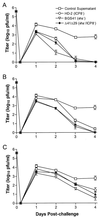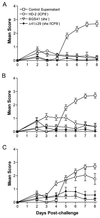Disruption of virion host shutoff activity improves the immunogenicity and protective capacity of a replication-incompetent herpes simplex virus type 1 vaccine strain
- PMID: 11070010
- PMCID: PMC113198
- DOI: 10.1128/jvi.74.23.11137-11144.2000
Disruption of virion host shutoff activity improves the immunogenicity and protective capacity of a replication-incompetent herpes simplex virus type 1 vaccine strain
Abstract
The virion host shutoff (vhs) protein encoded by herpes simplex virus type 1 (HSV-1) destabilizes both viral and host mRNAs. An HSV-1 strain with a mutation in vhs is attenuated in virulence and induces immune responses in mice that are protective against corneal infection with virulent HSV-1, but it has the capacity to establish latency. Similarly, a replication-incompetent HSV-1 strain with a mutation in ICP8 elicits an immune response protective against corneal challenge, but it may be limited in viral antigen production. We hypothesized therefore that inactivation of vhs in an ICP8(-) virus would yield a replication-incompetent mutant with enhanced immunogenicity and protective capacity. In this study, a vhs(-)/ICP8(-) HSV-1 mutant was engineered. BALB/c mice were immunized with incremental doses of the vhs(-)/ICP8(-) double mutant or vhs(-) or ICP8(-) single mutants, or the mice were mock immunized, and protective immunity against corneal challenge with virulent HSV-1 was assessed. Mice immunized with the vhs(-)/ICP8(-) mutant showed prechallenge serum immunoglobulin G titers comparable to those immunized with replication-competent vhs(-) virus and exceed those of mice immunized with the ICP8(-) single mutant. Following corneal challenge, the degrees of protection against ocular disease, weight loss, encephalitis, and establishment of latency were similar for vhs(-)/ICP8(-) and vhs(-) virus-vaccinated mice. Moreover, the double deleted vhs(-)/ICP8(-) virus protected mice better in all respects than the single deleted ICP8(-) mutant virus. The data indicate that inactivation of vhs in a replication-incompetent virus significantly enhances its protective efficacy while retaining its safety for potential human vaccination. Possible mechanisms of enhanced immunogenicity are discussed.
Figures







Similar articles
-
ICP8-vhs- HSV-2 Vaccine Expressing B7 Costimulation Molecules Optimizes Safety and Efficacy against HSV-2 Infection in Mice.Viruses. 2023 Jul 18;15(7):1570. doi: 10.3390/v15071570. Viruses. 2023. PMID: 37515256 Free PMC article.
-
Attenuated Herpes Simplex Virus 1 (HSV-1) Expressing a Mutant Form of ICP6 Stimulates a Strong Immune Response That Protects Mice against HSV-1-Induced Corneal Disease.J Virol. 2018 Aug 16;92(17):e01036-18. doi: 10.1128/JVI.01036-18. Print 2018 Sep 1. J Virol. 2018. PMID: 29950407 Free PMC article.
-
Therapeutic immunization with a virion host shutoff-defective, replication-incompetent herpes simplex virus type 1 strain limits recurrent herpetic ocular infection.J Virol. 2002 Apr;76(8):3615-25. doi: 10.1128/jvi.76.8.3615-3625.2002. J Virol. 2002. PMID: 11907201 Free PMC article.
-
Host shutoff activity of VHS and SOX-like proteins: role in viral survival and immune evasion.Virol J. 2020 May 19;17(1):68. doi: 10.1186/s12985-020-01336-8. Virol J. 2020. PMID: 32430029 Free PMC article. Review.
-
Alphaherpesvirus Subversion of Stress-Induced Translational Arrest.Viruses. 2016 Mar 15;8(3):81. doi: 10.3390/v8030081. Viruses. 2016. PMID: 26999187 Free PMC article. Review.
Cited by
-
ICP8-vhs- HSV-2 Vaccine Expressing B7 Costimulation Molecules Optimizes Safety and Efficacy against HSV-2 Infection in Mice.Viruses. 2023 Jul 18;15(7):1570. doi: 10.3390/v15071570. Viruses. 2023. PMID: 37515256 Free PMC article.
-
Recent progress in herpes simplex virus immunobiology and vaccine research.Clin Microbiol Rev. 2003 Jan;16(1):96-113. doi: 10.1128/CMR.16.1.96-113.2003. Clin Microbiol Rev. 2003. PMID: 12525427 Free PMC article. Review.
-
Oncolytic herpes simplex virus 1 encoding 15-prostaglandin dehydrogenase mitigates immune suppression and reduces ectopic primary and metastatic breast cancer in mice.J Virol. 2011 Jul;85(14):7363-71. doi: 10.1128/JVI.00098-11. Epub 2011 May 4. J Virol. 2011. PMID: 21543507 Free PMC article.
-
Herpes simplex virus virion host shutoff protein: immune evasion mediated by a viral RNase?J Virol. 2004 Feb;78(3):1063-8. doi: 10.1128/jvi.78.3.1063-1068.2004. J Virol. 2004. PMID: 14722261 Free PMC article. Review. No abstract available.
-
Mice with mutations in Fas and Fas ligand demonstrate increased herpetic stromal keratitis following corneal infection with HSV-1.J Immunol. 2012 Jan 15;188(2):793-9. doi: 10.4049/jimmunol.1102251. Epub 2011 Dec 7. J Immunol. 2012. PMID: 22156346 Free PMC article.
References
-
- Anonymous. Guide for the care and use of laboratory animals. DHHS publication 85-23 (NIH). Bethesda, Md: Committee on Care and Use of Laboratory Animals, National Institutes of Health; 1985.
-
- Brandt C R. Susceptibility of +/+ +/nu and nu/nu BALB/c mice to ocular herpes simplex virus infection. Ophthalmic Res. 1992;24:332–337. - PubMed
-
- Brubaker J O, Thompson C M, Morrison L A, Knipe D M, Siber G R, Finberg R W. Induction of Th1-associated immune responses to beta-galactosidase expressed by a replication-defective mutant of herpes simplex virus 1. J Immunol. 1996;157:1598–1604. - PubMed
-
- Coen D M, Irmiere A F, Jacobson J G, Kerns K M. Low levels of herpes simplex virus thymidine-thymidylate kinase are not limiting for sensitivity to certain antiviral drugs or for latency in a mouse model. Virology. 1989;168:221–231. - PubMed
Publication types
MeSH terms
Substances
Grants and funding
LinkOut - more resources
Full Text Sources
Other Literature Sources

